Majlis Design: Elevating Home Interiors with Tradition
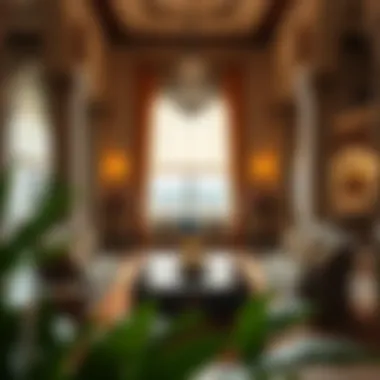
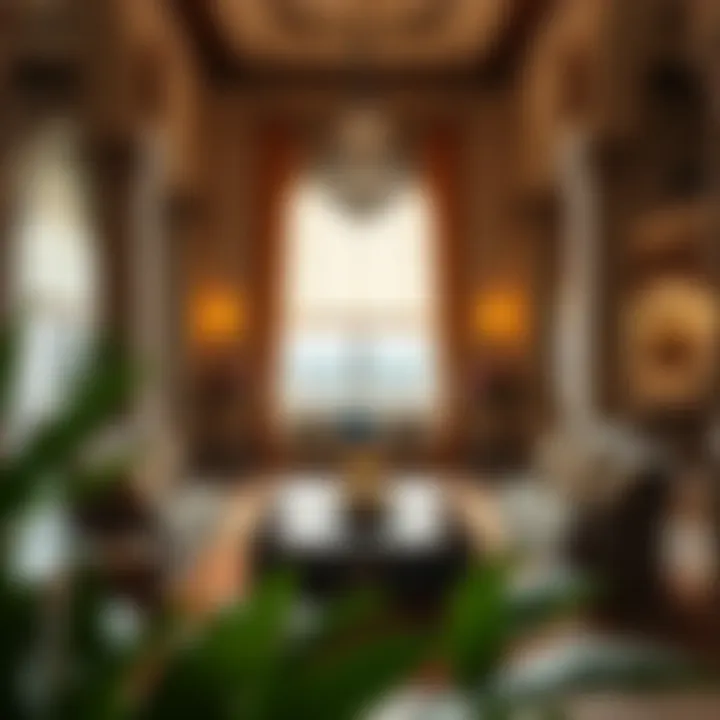
Intro
Creating a majlis in your home is more than just an aesthetic choice; it embodies a rich cultural legacy that communicates warmth and hospitality. Historically, the majlis has served as a gathering space, a spot for nuanced discussions, and a venue for shared experiences, making it the heart of a home in many Middle Eastern cultures. As societies evolve, the reinterpretation of this space has taken on new dimensions, blending tradition with modern sensibilities.
The essence of a well-designed majlis is its ability to foster social bonds. It is a reflection of the homeowner's personality while being deeply rooted in the values of community and comfort. When envisioning this space, considerations extend beyond mere decoration. The layout, furnishings, and even color palettes contribute to an environment that invites conversation and connection. Whether you are an avid hostess or simply looking to bring an air of sophistication into your abode, mastering the elements of majlis design can pave the way for an engaging and serene environment.
Navigating the Elements of Majlis Design
In this article, we'll delve into various components that shape a beautiful and practical majlis. Key points of exploration include:
- Cultural Significance: Understanding the traditions that inform modern majlis design.
- Essential Features: Highlighting the core elements every majlis needs, from seating arrangements to decoration.
- Modern Adaptations: Integrating contemporary styles while maintaining respect for tradition.
- Color Palettes: Crafting a soothing yet stylish environment.
- Furniture Arrangements: Creating spatial harmony for comfort and functionality.
As you embark on this journey through the intricacies of majlis design, remember it’s about weaving personal nuances into a tapestry of culture and community. By the end, you will have the insights needed to not only design a visually appealing majlis but also to foster an inviting atmosphere that echo personal and collective stories.
Understanding Majlis Design
Majlis design is not just about arranging furniture and selecting colors; it’s a journey into culture and tradition. This section aims to peel back the layers of majlis design, allowing readers to grasp its depth and significance. The majlis is often viewed as the heart of the home, where family and friends gather to share stories, ideas, and laughter. It's crucial to recognize that creating a majlis goes beyond aesthetics; it's about fostering community and embracing heritage.
Historical Context
The roots of majlis design can be traced back centuries, intertwining with the history of the Arabian Peninsula. Originally, these gathering spaces were often outdoors, providing shelter from the sun while promoting an open dialogue among guests. The architecture and layout were influenced by a nomadic lifestyle, focusing on communal interaction.
There’s something poignant about historical majlis spaces crafted from local materials, often designed with little more than a protective awning and simple seating. Over the years, as societies evolved, so did the architecture of homes. With the incorporation of modern materials and building techniques, the majlis transitioned into a more defined and stylistic space within the home while retaining its fundamental ethos of hospitality and community.
One can see how historically rich areas, like the Souks of Marrakech or the traditional Qatari homes, provide ample examples of how majlis design reveals itself through architecture. The structural elements often incorporate intricate tile work, traditional arches, and soft important lighting, reflecting the rich tapestry of each region’s cultural heritage. These factors create a historical relevance to majlis design that continues to influence contemporary interpretations.
Cultural Significance
A majlis is more than a mere room; it embodies the spirit and values of a culture deeply rooted in hospitality and social connection. In many Arab societies, this space serves as a sanctuary for conversing, negotiating, and even resolving disputes. For many expatriates or those unfamiliar, the majlis serves as a bridge, connecting them to the host culture through shared experiences.
The decor often reflects the local customs and traditions, allowing one to appreciate the nuances of various cultures. Colors, patterns, and materials used are indicative of not only aesthetic preference but also of social status and identity. In a way, the majlis can serve as a window into the societal norms and expectations of a community, showcasing what is valued and cherished.
Furthermore, the majlis holds significance during religious or festive occasions. For example, in the United Arab Emirates, it is customary to offer dates and Arabic coffee to guests, promoting the idea of generosity at the heart of social gatherings. This simple act demonstrates the importance of welcoming others into one’s home and life, making the majlis an essential aspect of cultural identity.
In summary, understanding majlis design entails appreciating its historical roots and cultural significance. As individuals explore the aesthetics and functionalities of a modern majlis, they should also remain cognizant of its role as a gathering place that fosters relationships and strengthens community bonds. By doing so, homeowners and designers can create spaces that are not only stylish but are also rich in meaning and context.
Key Features of a Majlis
The majlis is not just a simple gathering space; it embodies a rich tapestry of cultural and aesthetic elements. Without a doubt, understanding its key features is critical for anyone looking to design a space that is both functional and representative of cultural heritage. While the modern world leans heavily into clean lines and minimalist decor, the majlis invites a depth of opulence and a flavor of communal experience that is timeless. Whether it's for a home, an art gallery, or a more public setting, the essence of a majlis can be a powerful tool in transforming a dull area into a vibrant setting.
Seating Arrangements
Seating arrangements in a majlis set the tone for social interaction and community spirit. Traditionally, majlis seating uses low sofas and cushions, designed to encourage guests to sit comfortably at floor level. This not only fosters a relaxed environment but also promotes conversation and connection. Importantly, the arrangement can vary depending on the number of guests you're expecting and the nature of the gathering.
Consider the following:
- U-shaped or circular arrangements can enhance conversations, ensuring everyone feels included.
- Filling spaces with a mix of chairs, benches, and cushions allows flexibility, accommodating various group sizes and needs.
- Incorporating a focus piece, like a coffee table or decorative artifact, can add a centerpiece for community activities.
The seating should echo warmth and hospitality, embodying the very spirit of the majlis.
Flooring and Carpeting
Flooring and carpeting in a majlis are choices that reflect both practicality and style. It’s not uncommon to find intricate carpets or woven textiles that enhance acoustics while serving as a soft foundation for the seating arrangements. Traditionally, Persian or Oriental rugs are preferred for their history and craftsmanship. These textiles can be colorful, adorned with patterns, and often tell a story when examined closely.
Opting for luxurious materials like silk or wool can provide warmth, making the space inviting. On the flip side, contemporary designs may incorporate geometric patterns that align more with modern aesthetics while still yielding comfort.
Some considerations include:
- Easy maintenance: Carpet with stain-resistant properties can be essential for high-traffic areas.
- Layering rugs can create depth, visually separating areas for different activities or levels of formality.
Lighting Considerations
Lighting is critical to set the mood of any space, and a majlis is no exception. Soft, ambient lighting is preferred to create a welcoming atmosphere that invites social interaction. Natural light is coveted and should be maximized through large windows or skylights when possible. Yet, when daylight wanes, thoughtful artificial lighting becomes essential.
When designing, keep these aspects in mind:
- Dimmers are a fantastic option, allowing adjustment for different occasions—from a bright, lively ambience during gatherings to a dim, intimate setting for quiet moments.
- Consider traditional lanterns or modern pendant lights as focal points that also provide necessary illumination while enhancing aesthetic appeal.
- Utilizing wall sconces can create a cozy feel, washing walls in light and illuminating seating areas.
In summary, the key features of a majlis blend tradition with modernity—setting the stage for meaningful connections while respecting cultural nuances. Each choice, from seating to flooring and lighting, serves a purpose that goes beyond functionality, impacting the overall experience and home ambiance.
Design Elements to Consider
When creating a Majlis within a home, the design elements play a pivotal role in crafting an inviting atmosphere. The essence of this space lies in its ability to foster connections among family and guests. Thus, careful thought must be given to aspects such as color palettes, textiles, and decorative artifacts. These elements weave together the fabric of the Majlis, making it a true reflection of personal style while honoring traditional roots.
Color Palettes
The choice of color in a Majlis isn’t merely about aesthetics; it sets the tone and evokes feelings. Warm hues like deep reds or earthy browns create a cozy and intimate environment. Conversely, lighter shades might inject a sense of calmness and tranquility. When choosing a color palette, consider the light in the space.
- Natural Light: If your room gets plenty of sunlight, softer colors can enhance that brightness.
- Mood: Think about the vibe you want to create. Rich colors can energize the space, while pastel tones can invoke serenity.
Which colors do you want to surround yourself with? Highlighting certain shades can also accentuate architectural features, like arches or intricate wall designs. Bayrami.com offers a plethora of inspiration for modern palettes that are classic yet stylish.
Textiles and Fabrics
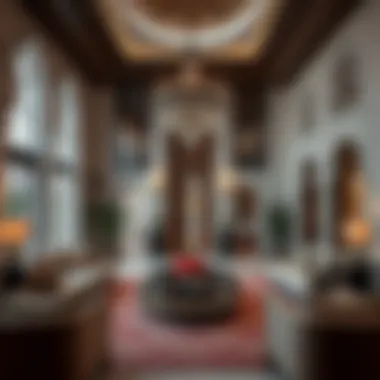
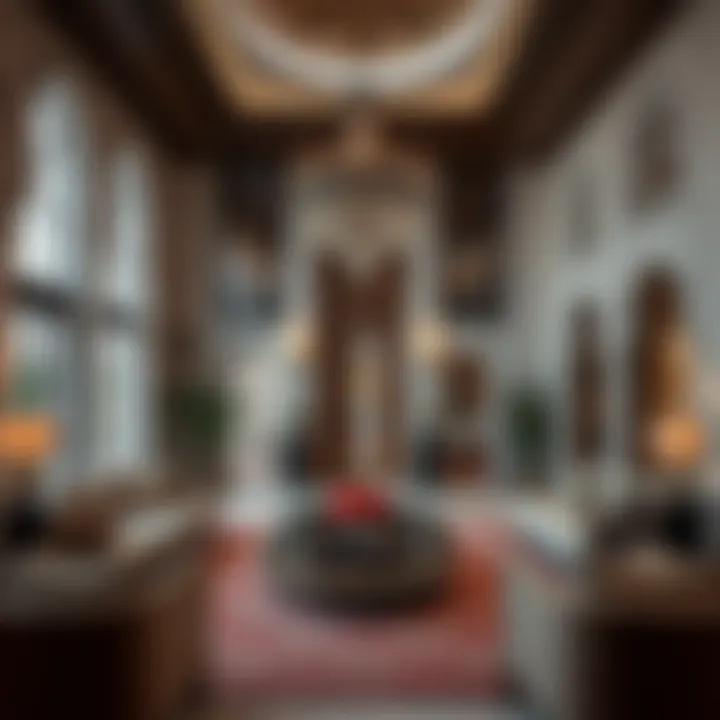
Textiles breathe life into the Majlis, offering comfort and depth. A hodgepodge of patterns can tell a story in a way that bare surfaces cannot. Using richly woven fabrics for cushions or upholstery can create a tactile experience, enticing guests to linger longer.
- Layering: Mixing different textures, such as silk, velvet, and cotton, brings a dynamic quality to the space.
- Meaningful Patterns: Choose textiles that carry cultural significance, perhaps with geometric designs that reflect the region’s art. Traditional weaving techniques from local artisans add a personal touch that mass-produced fabrics cannot match.
Moreover, consider incorporating rugs that complement the seating arrangements. The right rug can anchor the space and provide an inviting atmosphere. As seen on various design forums, the right layering of textiles is not just an art, it’s a way to seamlessly blend comfort and tradition.
Art and Decoration
Art pieces serve as focal points that animate the Majlis. Not only do they contribute to the overall aesthetic, but they provide insight into personal tastes and cultural heritage. Let the art be a conversation starter or a comforting reminder of home.
- Local Craftsmanship: Displaying locally made pieces can foster appreciation for community artisans. It’s a way to keep the tradition alive, whether through pottery, paintings, or traditional calligraphy.
- Functional Decor: Integrating decorative items that also serve a purpose can minimize clutter while adding charm. Think of carved wooden boxes or artistic trays used during coffee serving.
Deciding on the right art should resonate with your values and narrative. For example, if you value sustainability, selecting art made from recycled materials can reflect that ethos, as explored on resources like Pinterest and art-centric platforms.
By thoughtfully considering these elements, you lay the groundwork for a Majlis that invites connection, culture, and conversation.
Modern Interpretations of Majlis
Modern interpretations of Majlis are essential in understanding how traditional designs evolve to accommodate contemporary lifestyles. As homes become more multifunctional and the dynamics of social interaction shift, the Majlis must reflect these changes. The incorporation of modern concepts into this age-old practice brings forth not just aesthetic value but also practicality, blending culture with modern-day living.
Contemporary Styles
Contemporary styles in Majlis design prioritize clean lines, open spaces, and functionality, which resonate with today’s design sensibilities. Instead of the ornate, intricate patterns from the past, current Majlis designs may opt for a minimalist approach, focusing on simplicity yet exuding elegance. This can be achieved by integrating sleek furniture with surprising elements like geometric shapes or asymmetrical arrangements, which serve both functional and visual purposes.
Common features of contemporary styles include:
- Neutral Color Schemes: Shades of white, grey, and beige create a calm atmosphere, allowing other design elements to stand out.
- Multi-Purpose Furniture: Sofas that easily convert into beds or coffee tables with hidden storage cater to the needs of modern households.
- Bold Accents: Using colorful cushions or artwork can break the monotony of neutral tones, providing a focal point around which the entire space can revolve.
Such styles not only make the Majlis inviting but also enhance the functionality of a space that has historical significance in social gatherings.
Fusion of Traditional and Modern
The fusion of traditional and modern elements in Majlis design is akin to a dance between the old and the new. Balancing cultural heritage with contemporary standards can create a space that feels both familiar and fresh. This fusion might include traditional Arabic mashrabiya screens, which provide privacy while adding a decorative touch, coupled with modern furniture pieces that focus on comfort and usability.
Incorporating traditional motifs in contemporary design can involve:
- Use of Classic Textiles: Fabrics like silk or wool with traditional embroidery alongside modern furniture can breathe life into the space, making it culturally rich.
- Artistic Decor: Blending classic art pieces with modern sculptures or photographs can usher in a dialogue between eras.
- Lighting Features: Combining traditional lanterns with sleek LED fixtures can enhance ambiance while maintaining functional efficacy.
"Achieving this balance allows homeowners to honor their heritage while embracing innovation."
By weaving together historic and modern elements, one creates a Majlis that serves not only as a social arena but also as a testament to evolving tastes and lifestyles. This multifaceted approach not only attracts a diverse audience but speaks to their varied experiences, essentially ensuring that each Majlis tells a unique story.
Functional Aspects of Majlis Design
When considering the design of a majlis, it's crucial to understand the functional aspects that support its role as a central social space. This area is more than just a design showcase; it serves as a venue for gathering, discussion, and sharing experiences that hold great cultural value. Prioritizing functionality ensures that the majlis can meet the needs of family and guests alike. Let's delve deeper into two essentials: creating a welcoming environment and incorporating technology effectively.
Creating a Welcoming Environment
First impressions matter. The majlis should feel welcoming and inviting, encouraging guests to sit down and engage. A few key considerations can help achieve this:
- Layout: Arranging seating in a circular or semi-circular manner promotes interaction. Guests can easily engage in conversation without feeling isolated. Avoid configurations that block pathways; this promotes flow and accessibility.
- Comfortable Seating: Invest in plush cushions and low seating that encourages relaxation. The comfort of your guests should be paramount, making them feel at home. Materials like soft cotton or silk for cushions can enhance the tactile experience.
- Warm Lighting: Use soft, ambient lighting rather than harsh overhead bulbs. Options like floor lamps or wall sconces can add warmth and intimacy. A well-lit space feels more welcoming and can even influence mood.
- Personal Touches: Incorporating elements that reflect personal or cultural significance can transform a space into a reflection of identity. This might include artwork, photos, or traditional decor, creating a sense of belonging.
“A well-prepared majlis echoes the heart of the home, where warmth and comfort blend seamlessly.”
Creating a welcoming environment involves attentiveness to these details that balance aesthetics alongside comfort. It’s about crafting a space that feels inviting without sacrificing style.
Incorporating Technology
In today's fast-paced world, technology plays a vital role in enhancing the functionality of a majlis. Here’s how to seamlessly integrate modern advancements:
- Smart Home Integration: Devices that allow control over lighting, temperature, and audio can enhance comfort without compromising design. Think smart bulbs or thermostats that adjust automatically based on occupancy.
- Entertainment Features: A well-designed majlis can double as a media space. Consider built-in sound systems or hidden screens. These elements should blend into the design, maintaining the traditional aesthetic while offering modern conveniences.
- Wi-Fi Access: In an increasingly digital world, providing strong Wi-Fi connections is essential. A tech-friendly majlis allows guests to share experiences instantly, enhancing social interaction.
- Surveillance and security systems: If privacy is a concern, smart security solutions can be discreetly integrated. This ensures peace of mind, allowing hosts to focus on their guests.
Adopting these technological aspects can transform how a majlis functions, transforming it into not only a place for conversation but also for modern connectivity.
Understanding these functional aspects helps ensure that your majlis design remains not just beautiful but also practical and enriching for all who gather within.
Majlis in Various Home Settings
The majlis serves as a central point in homes, embodying not only a cultural hub but also a space where personal style and comfort converge. Understanding how to effectively incorporate a majlis in different home settings is paramount for implementing this traditional element while maintaining versatility and functionality. This section will explore the distinct contrasts between urban and traditional homes, and how smaller spaces can adapt to this concept without losing charm.
Urban vs. Traditional Homes
When exploring the application of majlis design in urban settings versus traditional homes, notable differences emerge. Urban residences often grapple with space constraints while aiming for modern appeal, while traditional homes might provide more expansive areas suitable for a classic majlis setup. Let's delve into the specifics:
- Urban Homes: Typically characterized by limited square footage, urban residences must approach majlis design with a strategic eye. An urban majlis might prioritize multifunctional furniture such as folding tables or modular sofas that can transform to accommodate gatherings without dominating the space. Additionally, incorporating vertical elements like wall-mounted plants or shelves can help enhance the aesthetic while conserving floor space.
- Traditional Homes: In contrast, these homes often feature larger areas, allowing for a more pronounced majlis design. Here, the seating can be expansive, often using rich fabrics with ornate patterns. Expansive carpets create inviting lounging areas, and decorative elements like intricate wall pieces or ornate lighting fixtures can thrive. The majlis in such homes often becomes a statement piece, marrying history and modernity.
Adapting to the characteristics of the home not only elevates the majlis aesthetic but also ensures functional harmony with the living environment.
Adaptations in Small Spaces
In today's world, where space is often at a premium, adapting the majlis design to fit smaller settings is not just necessary but also an art form. Here are several insightful approaches for successfully integrating a majlis into compact areas:
- Scalar Seating: Consider using low-profile seating options such as ottomans or floor cushions. These elements underscore comfort while ensuring that the area does not feel cramped. The beauty of such seating is its ability to easily shift and accommodate more guests when needed.
- Multipurpose Areas: Designing a small majlis requires thinking outside the box. The space can double as a cozy reading nook or a place for casual gatherings. Using a slim coffee table that can also be a workstation exemplifies this approach.
- Mirrors and Light: To create an illusion of space, mirrors can be strategically placed. They can reflect light and visually expand the area, enhancing the overall atmosphere of warmth and openness.
Incorporating a majlis in limited spaces should not lead to compromise; rather, it should invite ingenuity, ensuring that the majlis remains inviting and suitable for social interactions.
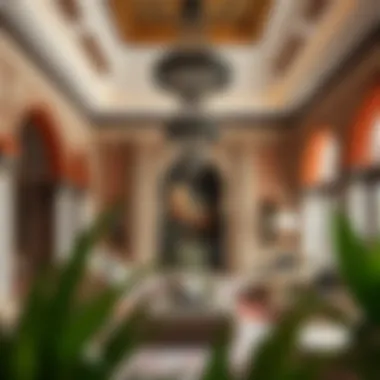
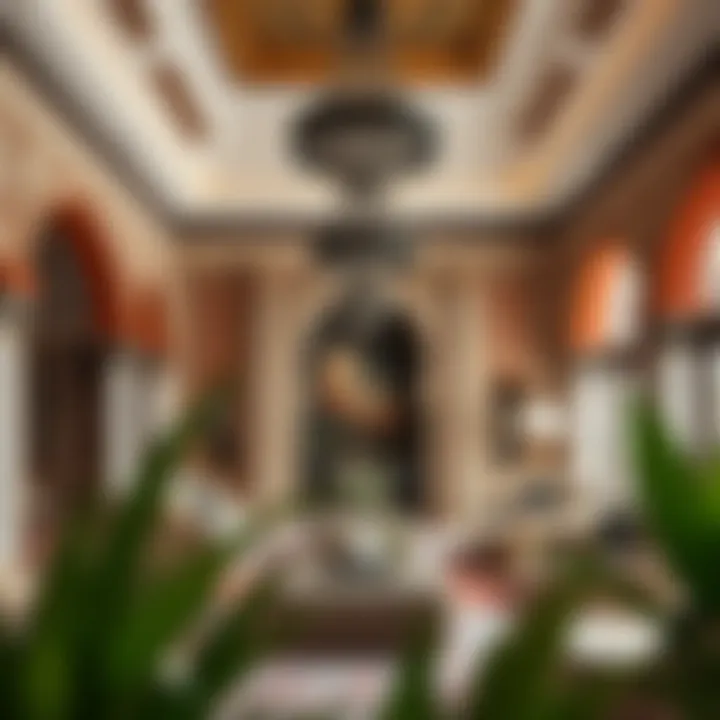
A well-thought-out majlis can turn any corner of a home into a welcoming haven, underscoring the need for thoughtful planning in both urban and small home settings.
Sustainability in Majlis Design
Sustainability in majlis design is crucial in today’s world, focusing on creating spaces that are not only beautiful but also kind to the environment. As homeowners become increasingly aware of the ecological footprint of their living spaces, the idea of sustainability takes center stage. A well-planned majlis can meld traditional aesthetics with eco-friendly practices, providing a setting for gatherings while minimizing negative impacts on the planet.
Adopting sustainable strategies in a majlis doesn’t just reflect a homeowner's commitment to the environment; it also enhances the quality of living. With the right choices, one can create a space that nourishes social bonds, honors heritage, and respects nature. To achieve this delicate balance, two vital aspects should be considered: selecting eco-friendly materials and implementing energy-efficient solutions.
Eco-friendly Materials
When it comes to majlis design, opting for eco-friendly materials is a significant leap towards sustainability. These materials are often sourced from renewable resources, reducing the depletion of natural concepts.
Choosing bamboo for flooring can be a smart decision. Bamboo grows quickly, making it a renewable choice that doesn’t sacrifice durability. In addition to bamboo, look for locally sourced wood to support regional artisans while also minimizing transportation emissions. Natural stone, which can lend a timeless look to the majlis, is also a viable option. However, it’s crucial to ensure that it’s ethically sourced to avoid contributing to environmental degradation.
Benefits of eco-friendly materials include:
- Reduced carbon footprint
- Improved indoor air quality
- Support for local economies
- Durability and longevity, saving resources in the long run
Furthermore, recycled materials such as reclaimed wood or repurposed metals can serve as fascinating focal points in your majlis design. This not only adds character but also tells a story of sustainability and creativity, making your space unique.
Energy-efficient Solutions
Incorporating energy-efficient solutions into a majlis design can drastically reduce energy consumption. It’s about smart choices that can save both money and energy.
Key energy-efficient solutions to consider include:
- LED Lighting: Advanced lighting solutions like LED bulbs last longer and consume less energy. They can create a warm ambience while being cost-efficient.
- Natural Ventilation: Designing the majlis to harness cross-ventilation can significantly reduce the need for air conditioning. Properly placed windows and openings can keep the space cool.
- Thermal Insulation: Investing in good insulation materials can help maintain temperature, ensuring that less energy is used for heating and cooling.
- Solar Panels: If feasible, installing solar panels can provide renewable energy to power your majlis, ultimately reducing energy bills.
Implementing these energy-efficient solutions not only contributes to sustainability but also creates a comfortable environment conducive to social interactions. In essence, the majlis transforms into not just a physical space but a harmonious blend of tradition, comfort, and ecological mindfulness, aligning beautifully with modern living ideals.
"It's not just about making spaces; it's about making a difference."
Integrating sustainable practices in majlis design offers both environmental benefits and personal satisfaction, making a positive impact for generations to come. By prioritizing eco-friendly materials and energy-efficient solutions, homeowners can create a wohle that resonates with both culture and conscience.
Designing for Comfort and Functionality
Creating a majlis that is both comfortable and functional goes beyond mere aesthetics; it requires thoughtful consideration of design principles that enhance the experience of the space. The importance of comfort in a majlis cannot be overstated. This is a gathering place for family and friends, a sanctuary where stories are shared, and connections are nurtured. Thus, a well-designed majlis should promote comfort while also ensuring functional performance—allowing seamless social interactions.
One of the primary goals in designing this space is to balance ergonomics and aesthetic appeal. Attention to how seating arrangements, furniture arrangements, and overall layout can impact the ease of movement and comfort levels is crucial. A space that feels cramped or poorly arranged can hinder conversation and diminish the welcoming atmosphere that a majlis aims to provide. To maximize functionality, it is vital to consider how different elements can work harmoniously—not only with each other but also with the cultural significance of the space.
Ergonomic Considerations
When it comes to ergonomics, the objective is to create a space that supports the well-being of its users. This can include selecting furniture that offers adequate support, is the right height, and allows for a relaxed posture. Sofas or cushions should be both plush yet provide enough firmness to support long conversations without discomfort.
Some critical aspects of ergonomic considerations in majlis design include:
- Seat Height and Depth: Ensuring that seating fits comfortably for various body types.
- Support: Using sofas with good back support helps maintain proper posture.
- Accessibility: Arrange seating to avoid creating barriers, allowing easy movement around the space.
- Materials: Choose textiles that breathe, like cotton or linen, to enhance comfort when seated for extended periods.
An inviting majlis must be spacious enough for guests to gather without feeling packed in. Thus, ensuring your seating is well-spread can promote an open atmosphere conducive to free-flowing dialogue.
Flexible Layouts
Flexibility in layout is also paramount. This aspect allows homeowners to adapt their majlis for different occasions, whether a casual family gathering or a more formal event. By creating a flexible layout, you can easily accommodate various group sizes and activities.
- Zoning: Consider breaking the space into distinct zones for different functions—perhaps a casual seating area and a more formal dining space. This way, you can cater to both relaxed gatherings and ceremonial festivities without sacrificing comfort.
- Moveable Furniture: Employ lightweight or modular furniture that can be easily rearranged. This not only allows for versatility but also encourages spontaneous gatherings.
- Integration of Technology: Incorporate technology discreetly, such as built-in sound systems or charging stations that don't disrupt the majlis atmosphere.
"A well-thought-out layout can transform a mundane area into an engaging and flexible environment, inspiring conversation and connection."
In summary, designing a majlis that successfully merges comfort with functionality is fundamental. It enhances the social interactions that occur within and greatly contributes to the cultural warmth so pivotal in these spaces. Whether through ergonomic offerings or flexible layouts, each element plays a part in crafting a space that echoes comfort, culture, and function.
Choosing the Right Decor
When it comes to creating an inviting yet functional majlis, the decor you choose plays a pivotal role. This space is not just one for receiving guests; it can set the tone for gatherings, reflect personal style, and demonstrate cultural appreciation. Therefore, selecting the right decor can transform a room from merely functional to a warm, welcoming environment that speaks volumes about the homeowner’s taste and background.
Considerations for Choosing Decor
When selecting decorations for your majlis, a few considerations will enhance the overall aesthetic:
- Cultural Resonance: Aim for pieces that resonate with local customs and traditions. This could mean incorporating intricate patterns, symbolic motifs, or colors that hold cultural significance.
- Material Selection: Choose materials that echo the history and innovation of the region. For instance, rich textiles, ceramic tiles, or handcrafted woodwork can contribute to a deeply rooted ambiance.
- Functional Versatility: While it’s important for decor to be visually pleasing, practicality should not take a backseat. Select items that serve a dual purpose, such as decorative cushions that offer comfort while enhancing the decor.
Choosing decor is not merely about filling space; it’s about creating an experience that is both pleasing and practical.
Cultural Artifacts
Incorporating cultural artifacts into your majlis decor is an excellent way to pay homage to your heritage. These artifacts often convey stories and histories that can become conversation starters for your guests.
Examples of Cultural Artifacts:
- Traditional Pottery: Handcrafted pottery pieces can symbolize the rich artistic traditions of the region. They may showcase ancient designs and colors that push to the forefront the beauty of craftsmanship.
- Folk Art: Paintings or sculptures that represent local folklore can imbue the space with a sense of identity and pride. Whether it be a depiction of local scenery or a reinterpretation of traditional themes, these elements add depth to your majlis.
- Textiles: Tapestries or woven items can connect the room with the artisan's roots. Often, textiles are rich in history and showcase the regions' unique dyeing techniques or weaving methods.
By integrating these artifacts into your majlis, you create an atmosphere that respects and acknowledges the cultural essence of the space.
Local Craftsmanship
Supporting local craftsmanship not only beautifies your majlis but also boosts the local economy and keeps traditional skills alive. Items made by local artisans often have unique qualities that mass-produced items do not possess.
Benefits of Including Local Crafts:
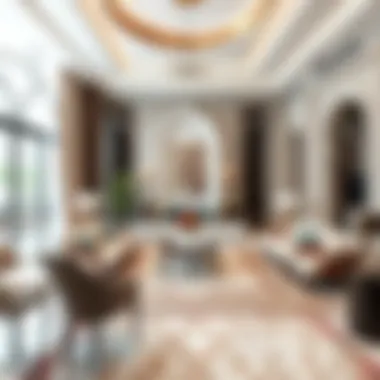
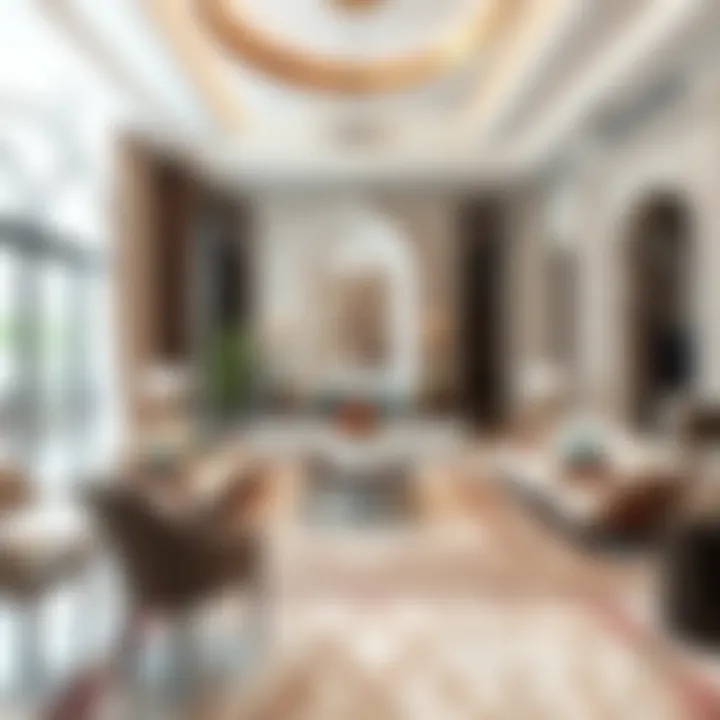
- Authenticity: Locally made decor items carry a certain authenticity that can enrich your space. Each piece tells a story, often reflecting the techniques and styles unique to the area.
- Quality: Custom or handcrafted items tend to exhibit superior craftsmanship that can stand the test of time as opposed to items churned out in factories.
- Unique Designs: Supporting local artisans may yield one-of-a-kind pieces that differentiate your majlis from others, adding character that demonstrates your personal style.
While selecting decor for your majlis, it’s crucial to remember that every choice contributes to the story you wish to tell. Your decor should foster a connection between the space and its cultural roots while embodying comfort and sophistication. For more insights into local artisans and cultural practices, consider exploring resources like en.wikipedia.org or britannica.com for a broader understanding.
Incorporating Nature into Majlis Design
The integration of natural elements into majlis design is not just a trend; it reflects a deeper understanding of creating spaces that resonate with serenity and comfort. Nature has a way of grounding our thoughts and enhancing the overall atmosphere, bringing in freshness to the confines of indoor spaces. By incorporating elements from the natural world, a majlis becomes more than a simple gathering area; it transforms into a sanctuary where tradition meets tranquility.
Indoor Plants
Bringing in indoor plants elevates the majlis experience remarkably. They serve practical purposes as well as aesthetic ones. For instance, plants such as the resilient snake plant or the elegant peace lily not only purify the air but also add a splash of verdant life to the environment. Indoor plants can be placed around seating areas, drawing the eye and inviting guests to enjoy a moment of nature’s peace.
Consider the following benefits of including indoor plants in your majlis:
- Air Quality Improvement: Plants like spider plants and golden pothos can absorb harmful toxins and help circulate fresh oxygen. This especially helps in urban homes where air exposure might be limited.
- Aesthetic Appeal: The shapes, colors, and textures of various plants can enhance the visual interest of your majlis. A bamboo palm can add height, while a succulent arrangement can serve as a chic centerpiece.
- Mood Enhancement: Studies show that being around greenery can enhance mood and reduce stress. This is vital in a space designated for gatherings and conversations.
Choosing the right plants ensures the majlis remains inviting and functional. Opt for low-maintenance varieties if the space is not always attended, as this ensures a lush appearance with minimal effort.
Natural Light
Natural light is a golden asset in any design ethos, especially in a majlis. The benefits of maximizing natural light cannot be overstated. It transforms the atmosphere, enhances color perceptions, and can even influence people’s moods. When designing a majlis, strategically placing windows or even skylights can bring an abundance of natural light into the space.
Here are some considerations for utilizing natural light:
- Window Placement: Orient windows to catch light during prime daylight hours. Using larger windows, such as floor-to-ceiling glass, can also create a flow between inside and outside. This makes the space feel larger and more inviting.
- Light-colored Surfaces: Use light-colored walls and furnishings to reflect natural light. Soft whites and gentle pastels can brighten the space, making it airy and welcoming.
- Translucent Screens: Incorporating sheer curtains or partitions can diffuse light elegantly while maintaining privacy. This allows daylight to create a dappled effect within the giant room without overwhelming the senses.
By thoughtfully incorporating indoor plants and maximizing natural light, the majlis design transcends mere function. It evolves into an immersive experience that not only respects cultural traditions but enriches the daily lives of those who gather there.
"Nature does not hurry, yet everything is accomplished." – Lao Tzu
There’s a certain bliss in nature's rhythm that embodies the spirit of a well-designed majlis, inviting connection and camaraderie for both family and guests.
Challenges in Majlis Design
When delving into the subtleties of Majlis design, one cannot overlook the inherent challenges that come alongside crafting this culturally rich space. The majlis serves not just as a living area; it embodies community and tradition, making its design both an art and a puzzle to solve. Understanding these challenges is crucial for designers and homeowners alike, as they navigate the intricacies of balancing aesthetics, functionality, and cultural resonance.
Space Limitations
In many urban settings, finding ample space can be akin to finding a needle in a haystack. The majlis, traditionally associated with expansive settings, often faces challenges when situated in modern, compact homes.
- Maximizing Functionality: It's essential to make every square inch count. Opt for multi-purpose furniture that can serve different functions, such as a table that doubles as storage or modular seating that can be rearranged as needed.
- Visual Tricks: Using colors and layout strategically can create an illusion of space. Light colors tend to open up environments, while mirrors can reflect light and give a sense of depth.
- Thoughtful Arrangements: Consider arrangements that promote interaction but don't crowd the space. An open layout encourages flow, while curved seating can be inviting and visually appealing.
Maintaining Cultural Relevance
Striking the right chord between modern trends and cultural heritage can be a tightrope walk. Majlis design must honor tradition while also embracing contemporary lifestyles.
- Historical Context and Modern Needs: It's vital to relay the historical significance of the majlis, showcasing traditional elements without coming across as outdated. This requires an understanding of what these elements mean within the culture.
- Integrating Local Crafts: Incorporating locally-sourced textiles and crafts can resonate with cultural significance while supporting artisans. This connection to the community enriches the majlis, making it more than just a room.
- Personal Expression: While traditional elements should be embraced, homeowners still desire spaces that reflect their identities. Combining inherited designs with personal touches—be it through artwork or heirlooms—can lead to a beautiful fusion that respects tradition while allowing for new interpretations.
"The majlis is not just a room; it's a sanctuary of socialization and a reflection of our values, both collected through individual experiences and cultural legacies."
By acknowledging these challenges, homeowners and designers can embark on a journey that respects cultural roots while adapting to modern life. Design should never be viewed as a static process but rather as an evolving narrative that captures the spirit of both community and individuality.
Expert Tips for Majlis Design
Creating a Majlis that reflects both cultural heritage and modern sensibilities requires careful thought and strategic planning. Expert tips serve as guiding light in this endeavor, shining through challenges and highlighting pathways to an aesthetically pleasing and functional space. These tips can bolster your understanding of the design process while maximizing both comfort and style.
Consulting with Designers
Engaging with a professional designer can significantly elevate the majlis design process. Designers bring a wealth of experience and insight, ensuring that your vision matches your needs while considering current trends in interior design. However, it’s important to align your stylistic preferences with what a designer can offer.
- Identifying Your Style: Before consulting a designer, take the time to understand your aesthetic preferences. Are you drawn to vibrant colors or muted tones? Traditional motifs or minimalist lines? Taking notes on what captivates you can help the designer craft something tailored to your tastes.
- Discussing Requirements: It isn’t just about looks. Talk with designers about the majlis's function. Will it host large gatherings or intimate conversations? A designer can suggest optimal layouts, seating arrangements, and other special elements for your space.
- Open Communication: Keep the lines of communication open. Provide constant feedback to ensure that the final product aligns with your vision. Remember that while they have expertise, it's your space, and your preferences matter.
Budgeting for Your Majlis
Creating a budget is vital to prevent the project from spiraling out of control. A well-planned budget helps prioritize expenses, making sure that spending aligns with essential needs and personal desires. Below, we explore some aspects crucial to budgeting for your majlis.
- Prioritize Accordingly: Determine what is non-negotiable in your design. Is it lavish fabrics? A statement piece of art? Knowing what to prioritize will guide your budget effectively.
- Seek Multiple Quotes: Don't settle for the first offer you get. Shop around for materials, craftspeople, and furniture. Having options broadens your choices and can sometimes lead to cost savings.
- Factor In Long-Term Costs: Consider energy-efficient options that might lower utility bills. Investing upfront in quality materials is essential for longevity. For instance, quality carpets or proper lighting can pay off in the long run by enhancing comfort and reducing maintenance costs.
- Leave Room for Contingencies: Building in a buffer for unexpected costs can save headaches later. Unforeseen circumstances can crop up, so it’s wise to set aside 10-15% of your budget for these situations.
In summary, the combination of professional insight and prudent budgeting lays a solid foundation for a majestic majlis design. Keeping abreast of trends while feeding in personal preferences allows for a unique outcome that speaks volumes about who you are. A well-designed majlis can stand as a harmonious blend of tradition and modernity, as well as a testament to thoughtful planning and execution.
Final Thoughts on Majlis in Modern Homes
As we draw to the conclusion of our exploration into majlis design, it becomes clear that this space is not merely a physical environment but a canvas for expression, culture, and community. The majlis serves multiple roles—a sanctuary for gathering, a stage for storytelling, and a place to celebrate heritage. Understanding its relevance in modern homes not only deepens our appreciation for architectural and interior design but also enhances our social interactions.
Reflecting Personal Identity
In today’s world where individuality is often championed, the majlis has the distinct capacity to reflect one’s personal identity. Homeowners can express their unique tastes and preferences through the choice of colors, textiles, and layout. Whether opting for a modern twist on traditional designs or harmoniously fusing various cultural elements, the majlis becomes like a mirror facing the personality of its owner. For instance, a vibrant color palette might resonate with a youth-filled, energetic vibe, while muted tones may offer a serene and calm atmosphere.
Additionally, incorporating unique art pieces or personal artifacts can tell stories—stories of travel, heritage, or passion. Everything from the pattern of the cushions to the sleekness of a modern coffee table plays a part in the narrative painted by the space. It’s crucial for homeowners to consider how their majlis design communicates their values and lifestyle choices. With designs that are thoughtful and intentional, we can make environments that are not just aesthetically pleasing but also deeply personal.
Future Trends
Looking ahead, the evolution of majlis design signals exciting possibilities that blend tradition with innovation. As society shifts, so do preferences regarding home environments. We are seeing a rise in the integration of technology, making way for smarter, more functional spaces. Features like built-in sound systems, adjustable lighting, and climate control can elevate the majlis experience significantly.
Sustainability, though, may soon take center stage, as environmental awareness grows. Homeowners are likely to prioritize eco-friendly materials and sustainable practices in their design choices, reflecting a broader consciousness toward the impact of architecture on the environment. The idea of using locally sourced materials not only minimizes carbon footprints but also celebrates local craftsmanship.
Moreover, a trend toward minimalism is anticipated; spaces will become more fluid and less about material accumulation, allowing for versatility in how they are used. With an emphasis on flexibility, homeowners might create modular designs within the majlis—spaces that accommodate varied gatherings, from intimate family evenings to larger social affairs.
"The majlis of the future integrates technology, sustainability, and flexibility without compromising on the essence of cultural significance."
In wrapping up our discourse on majlis design, it’s evident that this space can adapt beautifully to the evolving modern landscape while remaining anchored in its rich traditions. As homeowners gear up to craft their ideal majlis, they are not just creating a room; they are designing a holistic experience that reflects who they are and honors where they come from.



